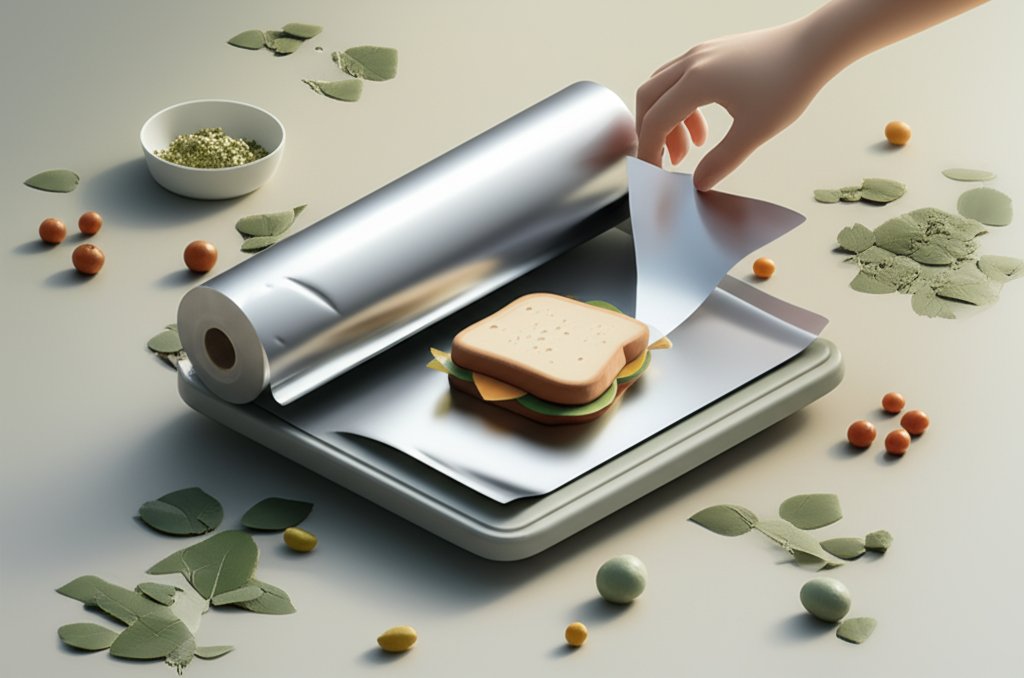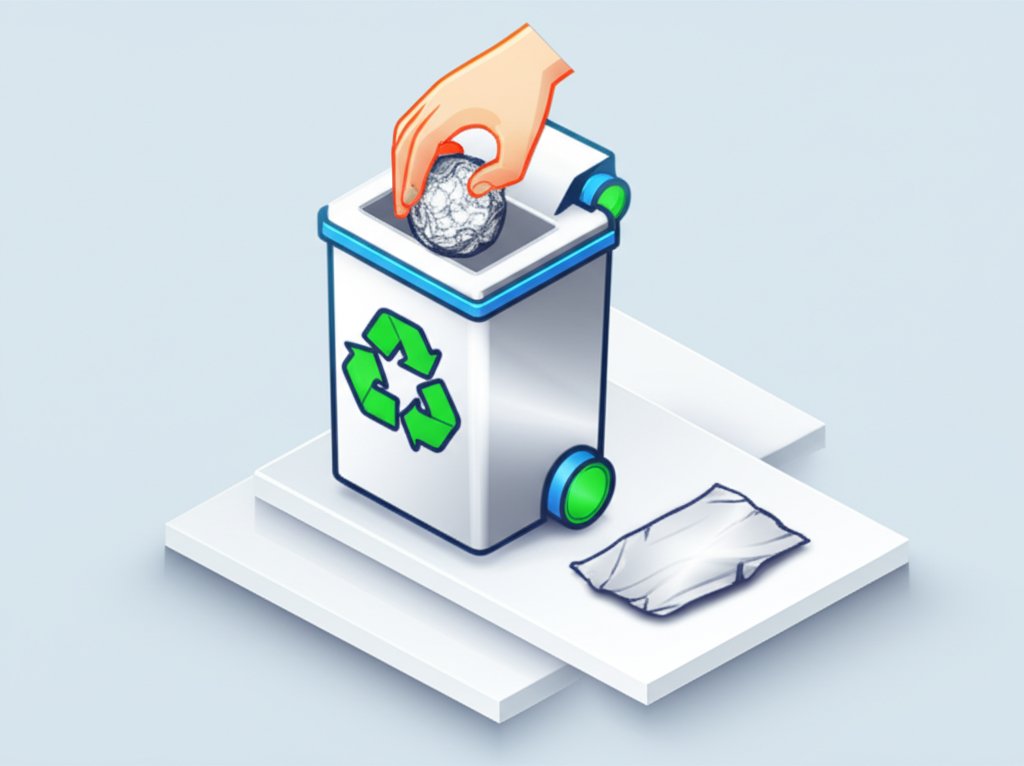Aluminum foil – the shimmering, versatile kitchen staple found in nearly every home. From wrapping leftovers to lining baking sheets, its convenience is undeniable. But beneath its shiny surface lies a complex environmental story, often misunderstood. Is this ubiquitous material truly eco-friendly? Can we practice sustainable uses of aluminum foil? How can we master recycling aluminum foil and even explore upcycling aluminum foil to minimize its impact?
This comprehensive guide will peel back the layers, revealing not just the challenges but also the immense potential for responsible stewardship of aluminum foil. We’ll delve into its lifecycle, explore ingenious ways to extend its utility, and provide actionable steps to ensure it becomes a champion in your fight against waste, rather than a contributor to it. Get ready to transform your perception of this everyday hero.
Understanding Aluminum Foil’s Environmental Footprint
To truly appreciate the eco-friendly potential of aluminum foil, we must first understand its journey from raw material to your kitchen drawer. While aluminum is one of the most abundant metallic elements, its extraction and production carry significant environmental costs.
From Bauxite to Your Kitchen: The Production Process
The story of aluminum foil begins deep within the earth, with bauxite ore. This reddish clay-like mineral is primarily mined in tropical and subtropical regions. The bauxite is then refined into alumina (aluminum oxide) through an energy-intensive process called the Bayer process. Next, the alumina undergoes electrolysis in smelters, where massive amounts of electricity are used to separate pure aluminum. Finally, this aluminum is cast into large ingots, which are then repeatedly rolled and stretched into the thin sheets we know as aluminum foil.
Each step – mining, refining, smelting, and rolling – demands substantial resources, leading to habitat disruption, considerable energy consumption, and the generation of waste products.
The Energy Equation: Why Manufacturing Matters
The primary environmental concern with virgin aluminum foil production is its colossal energy requirement. Smelting aluminum is an incredibly electricity-intensive process. This energy often comes from fossil fuels, contributing significantly to greenhouse gas emissions and climate change.
However, here’s where the eco-friendly narrative takes a turn: recycling aluminum saves up to 95% of the energy required to produce new aluminum from raw materials. This staggering efficiency makes recycling aluminum foil not just beneficial, but crucial for mitigating its initial environmental burden. By reducing the demand for new aluminum, we dramatically cut down on energy consumption, greenhouse gas emissions, and the need for further mining.
Comparing Foils: Aluminum vs. Other Wraps
When considering sustainable uses in the kitchen, aluminum foil often competes with plastic wrap and parchment paper. Each has its pros and cons:
- Plastic Wrap: Made from petroleum, plastic wrap is generally lightweight and effective for airtight sealing. Its production can have a lower initial fossil fuel footprint than virgin aluminum. However, plastic wrap is rarely recyclable in curbside programs, often ending up in landfills where it can take hundreds of years to break down and contribute to microplastic pollution.
- Parchment Paper: Typically made from wood pulp, parchment paper is often coated with silicone for non-stick properties. While some brands are compostable, this depends on the coating. It’s excellent for baking and preventing sticking, and its production footprint is generally lower than virgin aluminum, especially if sourced sustainably. It’s a good alternative for many baking applications.
- Aluminum Foil: As discussed, virgin production is energy-intensive. However, its infinite recyclability is a massive advantage. If properly
recycling aluminum foil, its long-term environmental performance significantly improves. It’s also superior for high-heat cooking and creating sealed packets for steaming or roasting.
The key takeaway is that an eco-friendly approach isn’t about eliminating aluminum foil entirely, but about making informed choices and maximizing its potential through sustainable uses and effective recycling aluminum foil.
Making Aluminum Foil Sustainable: Reduce, Reuse, Rethink
The most immediate and impactful way to promote sustainable uses of aluminum foil is to embrace the principles of “reduce” and “reuse” before even considering the recycling bin. Every time you extend the life of a piece of foil, you prevent the need for new production and reduce waste.
The Art of Reusing Aluminum Foil
Many people discard aluminum foil after a single use, but often, it has plenty of life left! Reusing foil is not only eco-friendly but also a smart way to save money.
Here’s how to elevate your foil reuse game:
- Clean Gently: If the foil has only lightly touched food (e.g., covering a baking dish of clean leftovers, wrapping a sandwich), gently wipe it clean with a damp cloth or sponge. Avoid harsh scrubbing, which can tear it.
- Smooth and Fold: Carefully smooth out any wrinkles and fold it neatly for storage. This makes it easier to use again and keeps your kitchen tidy.
- Specific Reuse Ideas:
- Covering Leftovers: For lightly soiled foil, simply re-cover bowls or plates in the fridge.
- Lining Baking Sheets: If only used to line a baking sheet for cookies or roasted vegetables that didn’t stick or spill, it can often be wiped clean and reused for a similar purpose.
- Protecting Small Plants: Wrap a piece of
aluminum foilloosely around the base of young plant stems to deter pests. - Cleaning Grill Grates: Crumple up a used piece of
aluminum foilinto a ball and use it to scrub stubborn residue off your grill grates. - Sharpening Scissors: Fold a sheet of foil several times and cut through it with dull scissors. The friction helps to sharpen the blades.
Smart Reduction Strategies: When Less is More
Sometimes, the most eco-friendly choice is simply to use less aluminum foil, or none at all.
- Ask Before You Use: Before reaching for the roll, pause and ask yourself: “Is
aluminum foiltruly necessary here, or is there a better, moresustainablealternative?” - Portion Control: Instead of using large sheets for small portions, consider if smaller pieces would suffice, or if non-foil options are available.
- Optimized Storage: For many food storage needs, airtight containers (glass or reusable plastic) are superior for freshness and completely reusable.
- Batch Cooking Smarter: If you’re batch cooking, consider how you’ll store everything. Maybe only a fraction of the items truly need foil.
Eco-Friendly Alternatives for Every Kitchen Need
Cultivating truly sustainable uses involves having a pantry full of diverse eco-friendly alternatives to aluminum foil.
- For Food Storage:
- Glass Containers: Durable, microwave-safe, oven-safe (without lid), infinitely reusable, and don’t leach chemicals.
- Stainless Steel Containers: Lightweight, durable, great for lunches and picnics, non-reactive.
- Beeswax Wraps: A natural, breathable, reusable alternative for wrapping sandwiches, cheese, fruits, and covering bowls. Easily cleaned and refreshed.
- Silicone Food Covers: Stretchable lids that fit various container sizes, creating an airtight seal.
- For Baking & Roasting:
- Parchment Paper: Excellent for non-stick baking and easy cleanup, especially for delicate items.
- Silicone Baking Mats: Reusable, non-stick, and can withstand high temperatures, reducing the need for foil liners.
- Ceramic or Glass Bakeware: Naturally non-stick with proper seasoning or oil, and completely reusable.
- For Cooking:
- Dutch Ovens & Covered Casserole Dishes: Ideal for slow cooking and roasting, eliminating the need for a foil cover.
- Steamer Baskets: For steaming vegetables without any wrap.
By strategically incorporating these alternatives, you can significantly reduce your reliance on aluminum foil while maintaining kitchen efficiency and embracing a more eco-friendly lifestyle.
Mastering Aluminum Foil Recycling: A Step-by-Step Guide
Even with diligent efforts to reduce and reuse, aluminum foil will eventually reach the end of its practical life. At this point, recycling aluminum foil becomes paramount. Thanks to aluminum’s unique properties, it can be recycled endlessly without loss of quality, making it a cornerstone of sustainable uses.
Why Recycling Aluminum Foil is Crucial
The benefits of recycling aluminum foil extend far beyond simply keeping it out of landfills:
- Massive Energy Savings: As mentioned, recycling uses only about 5% of the energy required to make new aluminum. This translates to enormous reductions in electricity consumption and associated greenhouse gas emissions.
- Resource Conservation:
Aluminum foilis part of a closed-loop system. When recycled, it returns to manufacturers to become new cans, foils, or other products, reducing the demand for virgin bauxite mining. Approximately 75% of all aluminum ever produced is still in use today because it can be recycled indefinitely. - Landfill Diversion:
Aluminum foilis not biodegradable. If sent to a landfill, it would remain intact for centuries, taking up valuable space. Byrecycling aluminum foil, we prevent this durable material from becoming long-term waste.
The “Clean and Scrunch” Method: How to Recycle Properly
While aluminum foil is highly recyclable, proper preparation is key to ensuring it actually makes it through the recycling process and doesn’t contaminate other materials.
Here’s your step-by-step guide for recycling aluminum foil:
After diligently recycling aluminum foil, ensure proper storage of all your recyclables to maintain a clean and organized system, perhaps following guidelines on how recyclables should be stored to optimize your space and reduce potential contamination.
- Clean Off Food Residue Thoroughly: This is the most critical step. Food particles can contaminate the recycling stream, attracting pests, causing mold, and potentially leading to the rejection of entire batches of recyclables.
- Lightly Soiled Foil: Wipe away any crumbs, grease, or food bits with a paper towel or sponge.
- Heavily Soiled Foil: If the foil is heavily encrusted with food or grease (e.g., from roasted chicken), it might be too contaminated for recycling. In such cases, cleaning uses more resources (water, soap) than the environmental benefit derived from recycling. Consider these pieces for
upcycling aluminum foilinto cleaning scrubbers or discard if too far gone.
- Do the Scrunch Test: Take a piece of
aluminum foilyou intend to recycle and scrunch it into a ball. If it holds its shape, it’s likely pure enough aluminum to be recyclable. If it springs back open, it might be a different material (like a metallic plastic film) and should not be recycled with aluminum. - Crumple into a Solid Ball: Small, flat pieces of
aluminum foilcan get lost during the sorting process at recycling facilities. To prevent this, crumple all clean pieces ofaluminum foilinto a single, compact ball. This ball should be at least the size of a golf ball or larger. Creating a denser mass helps it be correctly identified and processed by sorting machinery. - Combine Small Pieces: If you have several small, clean pieces, scrunch them together into one larger ball.
- Check Local Guidelines: Always confirm with your local recycling program. While most curbside programs accept clean, balled
aluminum foil, some smaller facilities might have different rules.
Addressing Common Recycling Myths and Challenges
- Foil with Laminated Layers: If
aluminum foilis bonded to other materials (like paper or plastic in some packaging), it’s generally not recyclable in standard curbside programs as the materials cannot be easily separated. - Small Scraps: Tiny pieces of foil, like those from candy wrappers or bottle tops, are usually too small to be efficiently sorted and recycled unless they are scrunched into a larger ball with other foil.
- Food Contamination: Again, this is the biggest hurdle. A little grease is fine if the foil is wiped, but heavily caked-on food or oil will usually lead to rejection.
Beyond the Bin: Community and Industrial Recycling Initiatives
In some areas, schools or community centers may host special collection drives for aluminum foil, often working with scrap metal recyclers. Industrially, recycled aluminum is used in a vast array of products, from new beverage cans and automobile parts to construction materials and, of course, new aluminum foil. Your efforts contribute to this global circular economy.
Beyond the Kitchen: Creative Upcycling Ideas for Aluminum Foil

Upcycling aluminum foil takes sustainable uses to the next level, transforming used or slightly soiled foil into something new, useful, or even artistic, rather than simply putting it in the recycling bin or discarding it. This creative approach extends its life cycle and reduces waste in innovative ways.
Household Hacks: Practical Upcycling in Action
Don’t toss that slightly used aluminum foil just yet! Many practical household problems can be solved with a bit of ingenuity and some leftover foil:
- Scrubbing Power: Crumple up a piece of
aluminum foilto create an abrasive scrubber for stubborn pots and pans (use with care on non-stick surfaces). It’s particularly effective for cleaning cast iron. - Silver Polishing: Line a glass dish with
aluminum foil, add hot water, a tablespoon of salt, and a tablespoon of baking soda. Submerge tarnished silver items, and watch the tarnish transfer to the foil. - Funnel Substitute: Shape a piece of
aluminum foilinto a funnel for pouring liquids or small grains without spills. - Rust Remover: Ball up
aluminum foiland use it to gently rub away rust spots from chrome fixtures or metal tools, often with just a little water. - Temporary Furniture Repair: If a table or chair leg is wobbly, fold a piece of
aluminum foilinto a shim and wedge it under the leg for a quick fix. - Cleaning Iron: Run a hot iron over a sheet of
aluminum foilsprinkled with salt to remove sticky residue.
Artistic Endeavors: Transforming Foil into Art
Upcycling aluminum foil can unleash your inner artist. Its malleability and metallic sheen make it a surprisingly versatile medium for creative projects:
- Foil Sculptures: From intricate figurines to abstract forms,
aluminum foilcan be molded and shaped into various sculptural pieces. Its reflective surface adds a unique dimension. - Textured Art: Pressing natural objects (leaves, lace) or patterned items onto
aluminum foilcan create interesting textures and reliefs for mixed-media art or decorative panels. - Ornaments and Decorations: Cut into festive shapes, embossed, or painted,
upcycled aluminum foilcan become holiday ornaments, gift tags, or decorative accents for home decor. - Jewelry Making: Create lightweight pendants, earrings, or beads by shaping and compressing layers of
aluminum foil. - Mosaics: Tear or cut small pieces of foil and glue them onto a surface to create a shimmering mosaic effect.
Educational & Kids’ Activities with Upcycled Foil
Engage children (and adults!) in eco-friendly practices through fun, educational activities using upcycled aluminum foil:
- Science Experiments: Explore concepts like conductivity or static electricity using
aluminum foilas a simple, safe material. - Craft Projects: From making robots to futuristic landscapes,
aluminum foilis an accessible and exciting material for kids’ crafts, encouraging creativity and resourcefulness. - Sensory Play: For younger children, the crinkly sound and shiny texture of
aluminum foilcan be used in sensory bins or for tactile exploration (ensure no sharp edges).
By embracing upcycling aluminum foil, we not only divert waste but also discover new value and purpose in a material often regarded as disposable. It’s a testament to how resourcefulness and creativity are vital components of a truly sustainable lifestyle.
Safety First: Using Aluminum Foil Responsibly

While aluminum foil is celebrated for its convenience and sustainable uses through recycling and upcycling, it’s also important to address potential safety concerns, particularly when used for cooking. An eco-friendly approach includes mindful usage that prioritizes both environmental and personal health.
Aluminum Leaching: Understanding the Risks
Research suggests that aluminum foil can leach small amounts of aluminum into food, especially when exposed to high temperatures, acidic ingredients (like tomatoes, lemon juice, vinegar), or salty foods. While the human body can excrete small amounts of aluminum, prolonged exposure or high intake has been a subject of scientific study regarding potential health impacts, though definitive conclusions are still being researched.
It’s generally understood that the amount of leaching increases with:
For most healthy individuals, occasional cooking with aluminum foil is not considered a significant health risk. However, understanding the potential for leaching allows for more sustainable uses practices that minimize exposure.
Best Practices for Cooking with Aluminum Foil
To balance convenience with safety and promote sustainable uses of aluminum foil in cooking, consider these best practices:
- Avoid Direct Contact with Acidic or Salty Foods: Whenever possible, avoid wrapping highly acidic foods (like citrus, tomatoes, or vinegar-marinated meats) or very salty items directly in
aluminum foilfor cooking or grilling, especially at high temperatures. - Use Parchment Paper as a Barrier: Line
aluminum foilwith parchment paper when cooking acidic or salty foods. This creates a barrier between the food and the foil, preventing direct contact and significantly reducing any potential for aluminum leaching. - Opt for Alternatives for High-Heat Cooking: For oven baking and roasting, consider using glass, ceramic, or stainless steel cookware instead of
aluminum foilwhen practical. Silicone baking mats are also excellenteco-friendlyalternatives. - Cover, Don’t Wrap Completely: When covering dishes to retain moisture, simply place
aluminum foilloosely over the top rather than sealing the food completely within it, reducing direct food-foil contact. - Be Mindful of Storage: For long-term food storage in the refrigerator, use glass or airtight containers instead of
aluminum foil, especially for leftovers containing acidic sauces. - Evaluate Reusability: When reusing
aluminum foilfor cooking, ensure it’s not heavily soiled or degraded, as physical damage can increase leaching potential.
By adopting these mindful practices, you can enjoy the practical benefits of aluminum foil while minimizing potential risks and promoting a truly holistic approach to eco-friendly kitchen management.
Conclusion
From its energy-intensive origins to its astonishing capacity for recycling aluminum foil and upcycling aluminum foil, aluminum foil presents a compelling paradox of modern convenience and environmental responsibility. It’s clear that this ubiquitous material is neither inherently “good” nor “bad” for the planet, but rather its eco-friendly status hinges entirely on our approach to its sustainable uses.
By understanding its environmental footprint, embracing the power of reduction and reuse, and rigorously adhering to proper recycling aluminum foil techniques, we transform it from a potential waste contributor into a valuable resource. Furthermore, the creative potential unlocked through upcycling aluminum foil adds another layer of sustainable magic, proving that with a little thought, we can find new life and purpose in even the most common items.
The journey towards a greener future is paved with conscious choices. Let’s commit to making aluminum foil a true partner in our eco-friendly kitchens, leveraging its strengths while mitigating its weaknesses. Embrace the principles outlined in this guide, and you’ll not only minimize your environmental impact but also inspire a more resourceful and sustainable way of living. Your kitchen, and the planet, will thank you.
FAQ
Q1: Is aluminum foil considered an eco-friendly material?
A1: While the initial production of virgin aluminum foil is energy-intensive and has a significant environmental footprint, its eco-friendly status greatly improves due to its infinite recyclability. Recycling aluminum foil saves up to 95% of the energy compared to making new aluminum. Thus, its environmental impact depends heavily on whether it’s properly recycled and reused.
Q2: How should I prepare aluminum foil for recycling?
A2: To properly recycle aluminum foil, first clean off any food residue thoroughly. Then, scrunch it into a compact ball that is at least the size of a golf ball. This “clean and scrunch” method helps it be recognized and processed by recycling machinery. Always check your local recycling guidelines for specific requirements.
Q3: What are some good eco-friendly alternatives to aluminum foil in the kitchen?
A3: Excellent eco-friendly alternatives include glass containers, stainless steel containers, beeswax wraps, and silicone food covers for storage. For baking, consider parchment paper or reusable silicone baking mats. Covered casserole dishes and Dutch ovens negate the need for foil when roasting or slow cooking.
Q4: Can I reuse aluminum foil, and what are some examples of sustainable uses?
A4: Yes, you can absolutely reuse aluminum foil if it’s not heavily soiled. Sustainable uses include gently wiping it clean and using it again to cover leftovers, lining baking sheets for light-use items, protecting young plants from pests, sharpening dull scissors, or scrubbing grill grates.
Q5: Are there health concerns when cooking with aluminum foil?
A5: Some research indicates that aluminum foil can leach small amounts of aluminum into food, particularly when cooking acidic (e.g., tomatoes, lemon), salty, or heavily spiced foods at high temperatures. To minimize potential risks, avoid direct contact between these foods and the foil, use parchment paper as a barrier, and opt for non-aluminum cookware when possible.
Q6: What does “upcycling aluminum foil” mean, and can you give examples?
A6: Upcycling aluminum foil means transforming used foil into something new and useful, rather than simply discarding or recycling it. Examples include shaping it into sculptures or decorative art, using it to polish silver or remove rust, creating a temporary funnel, or incorporating it into various craft projects for household hacks or artistic endeavors.










